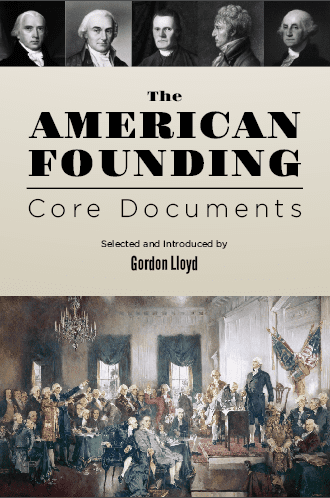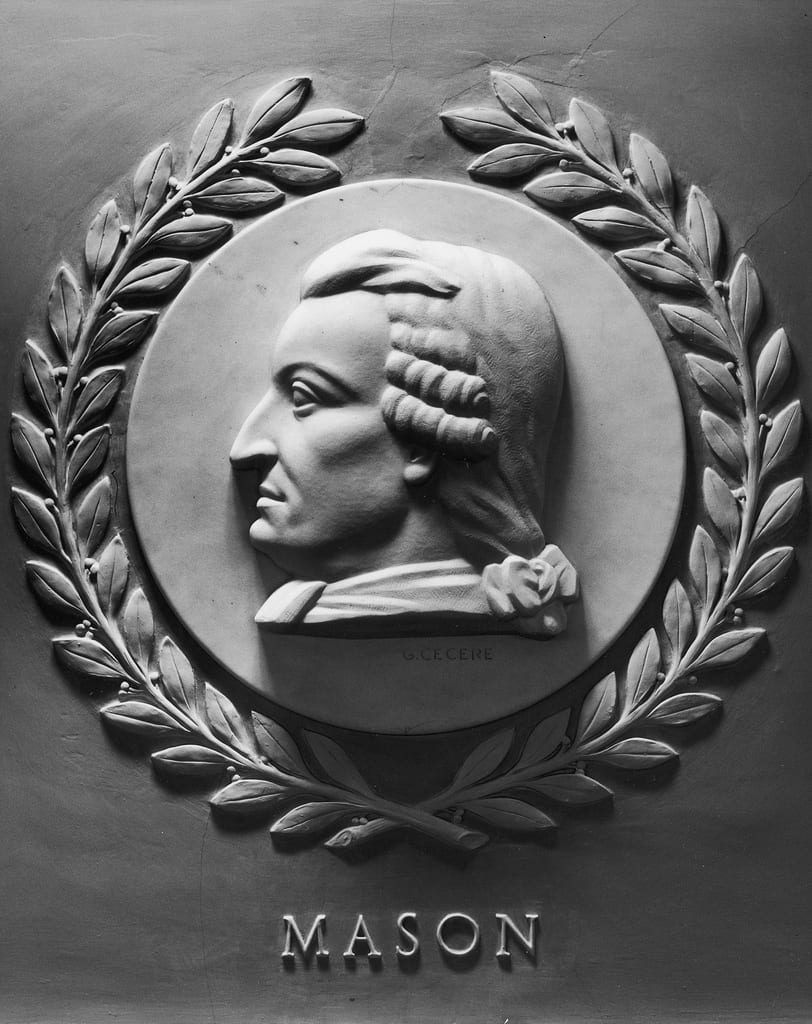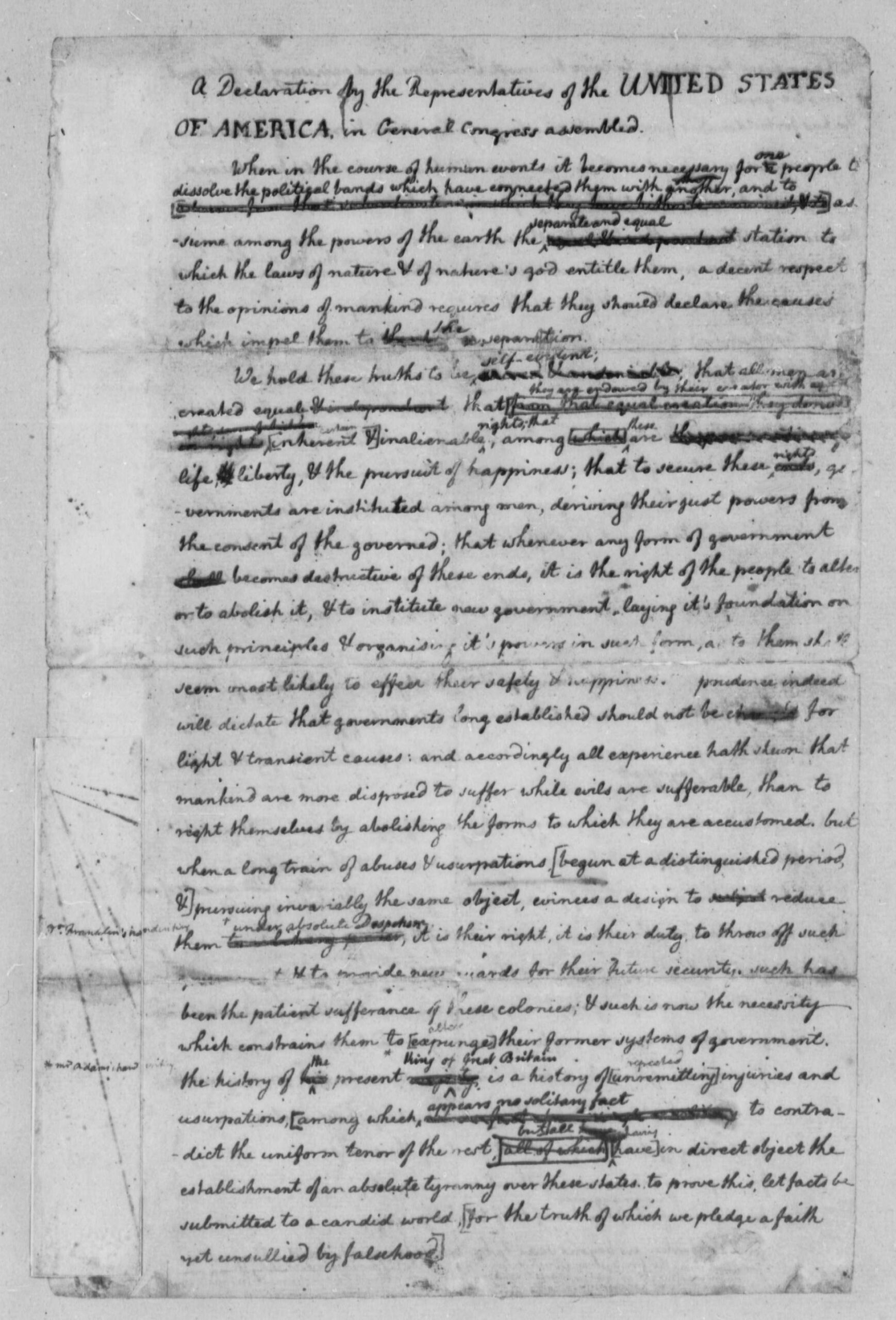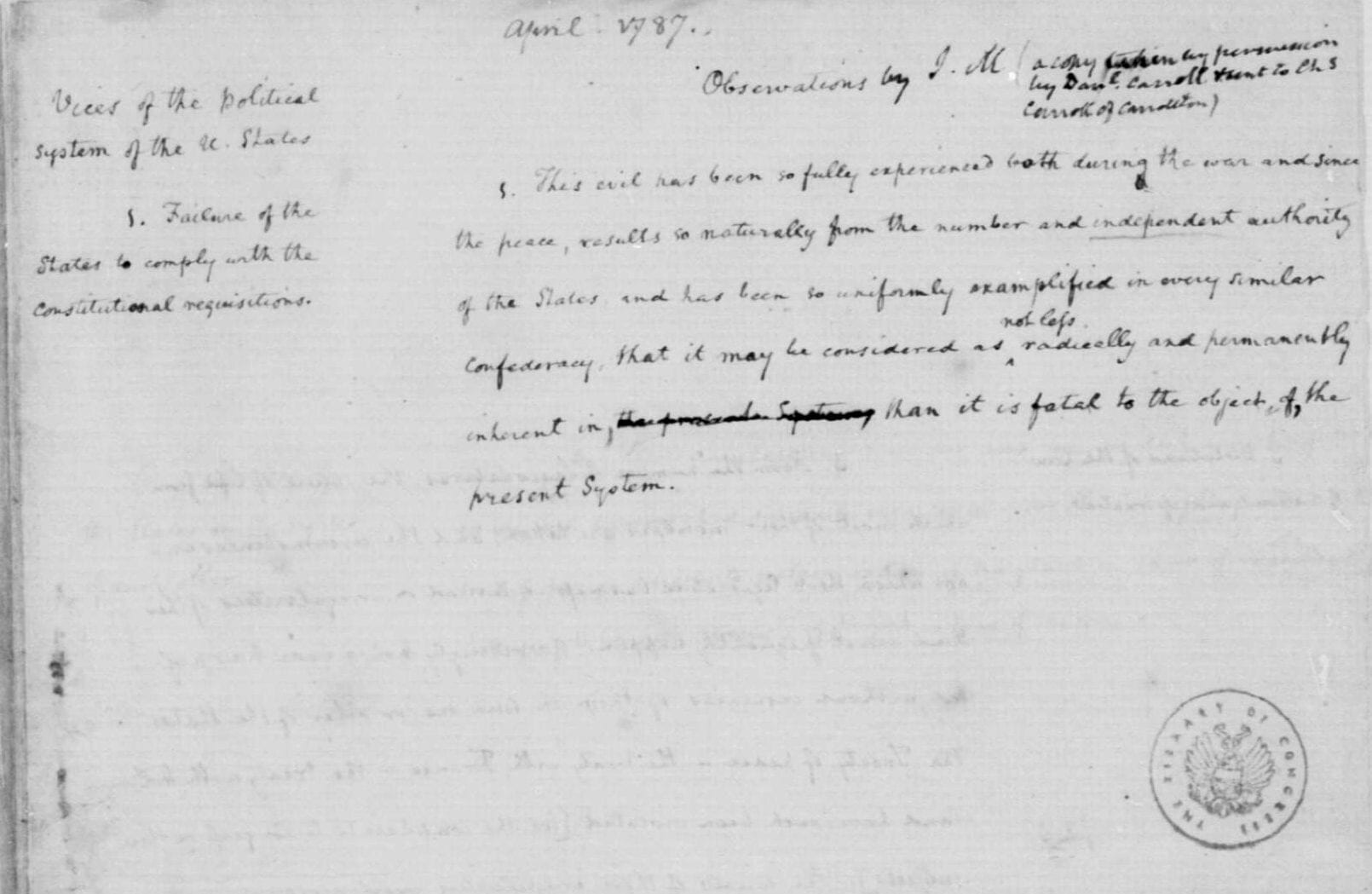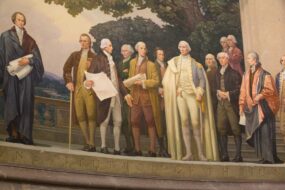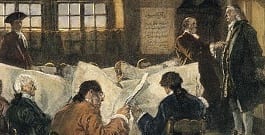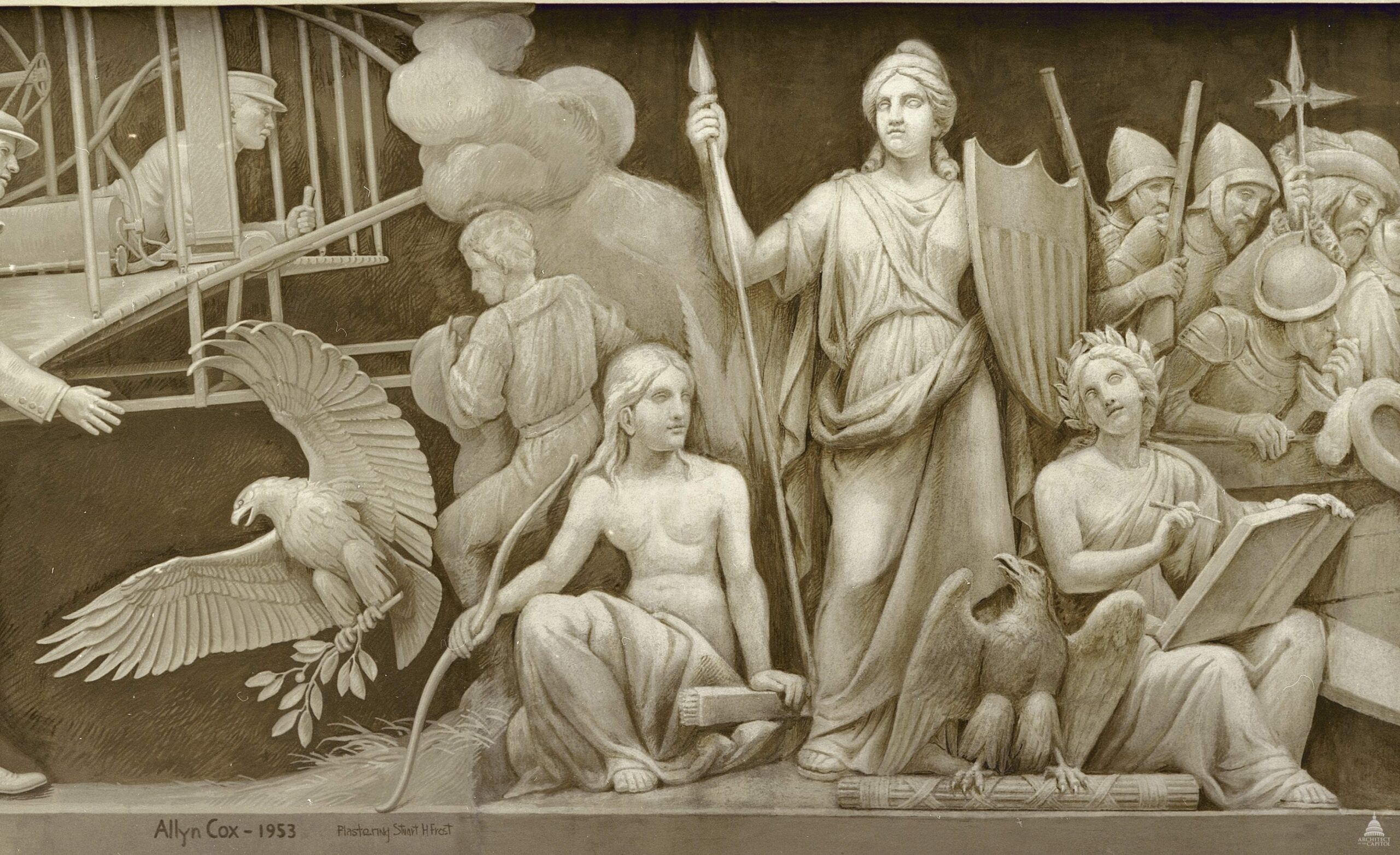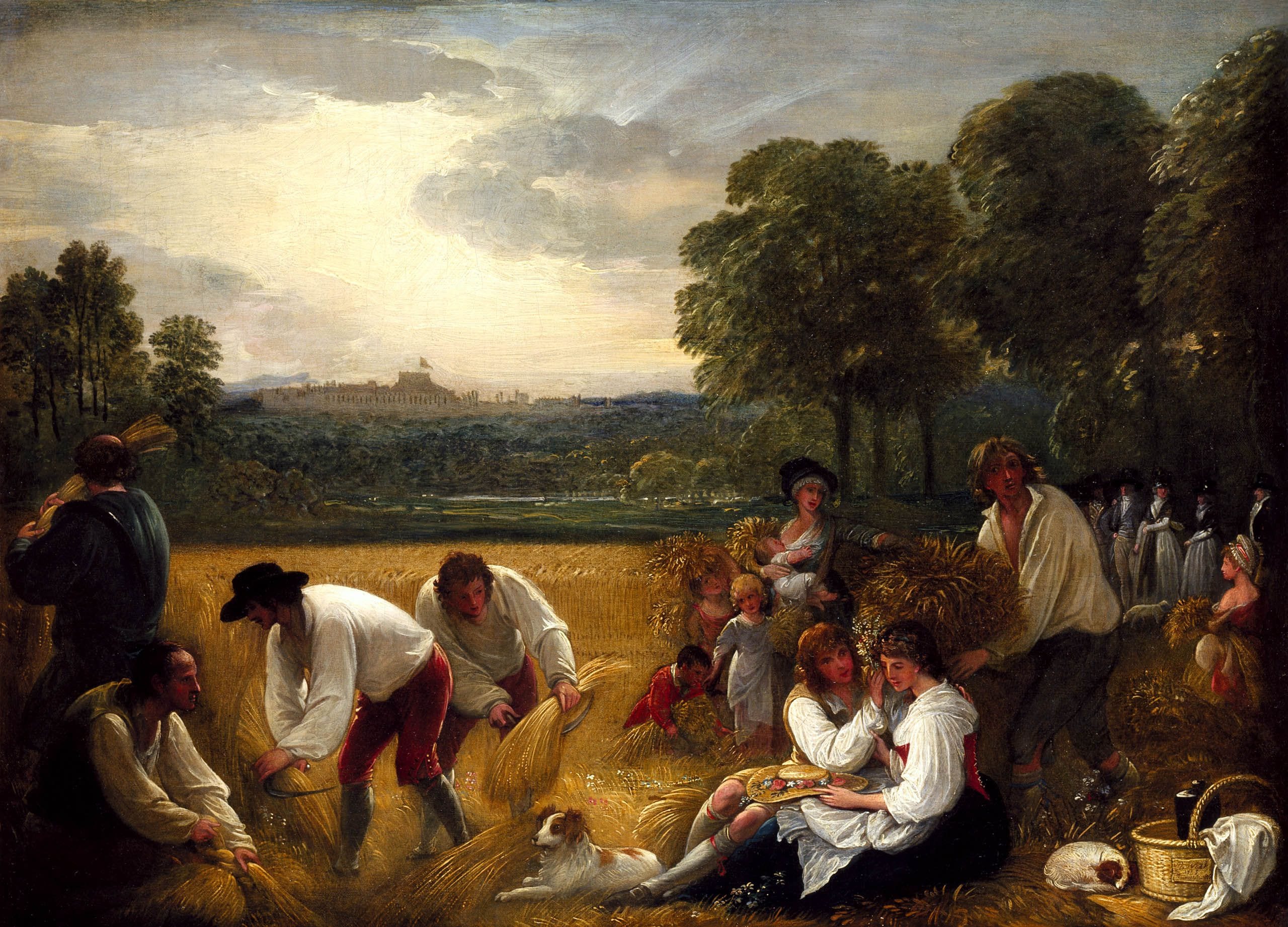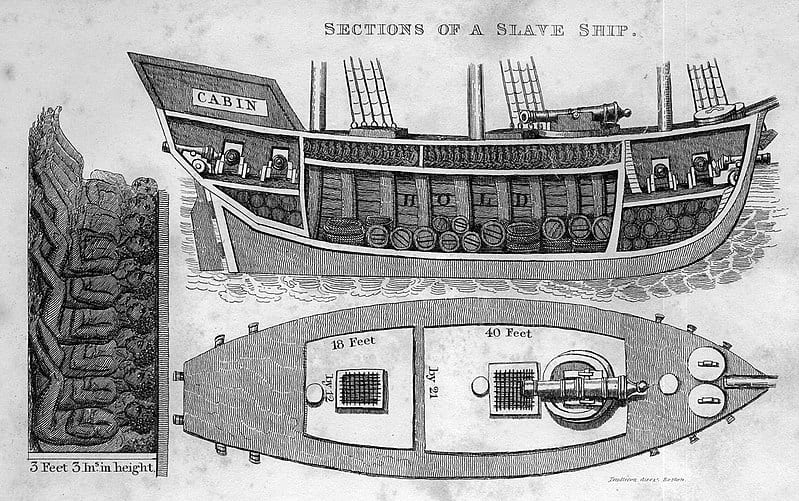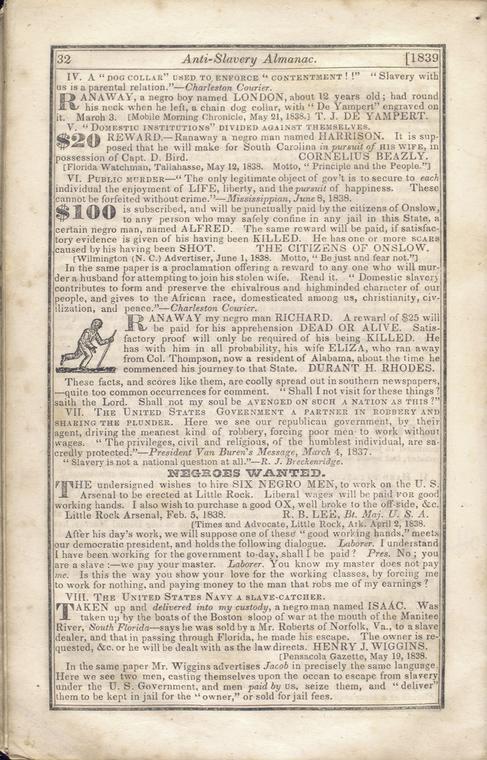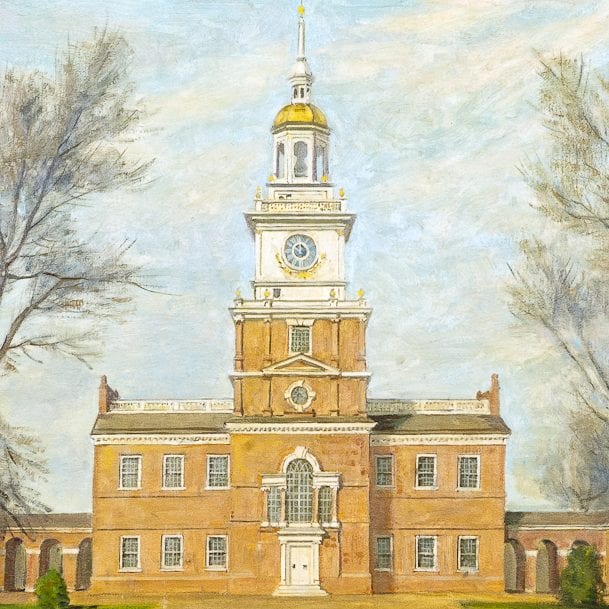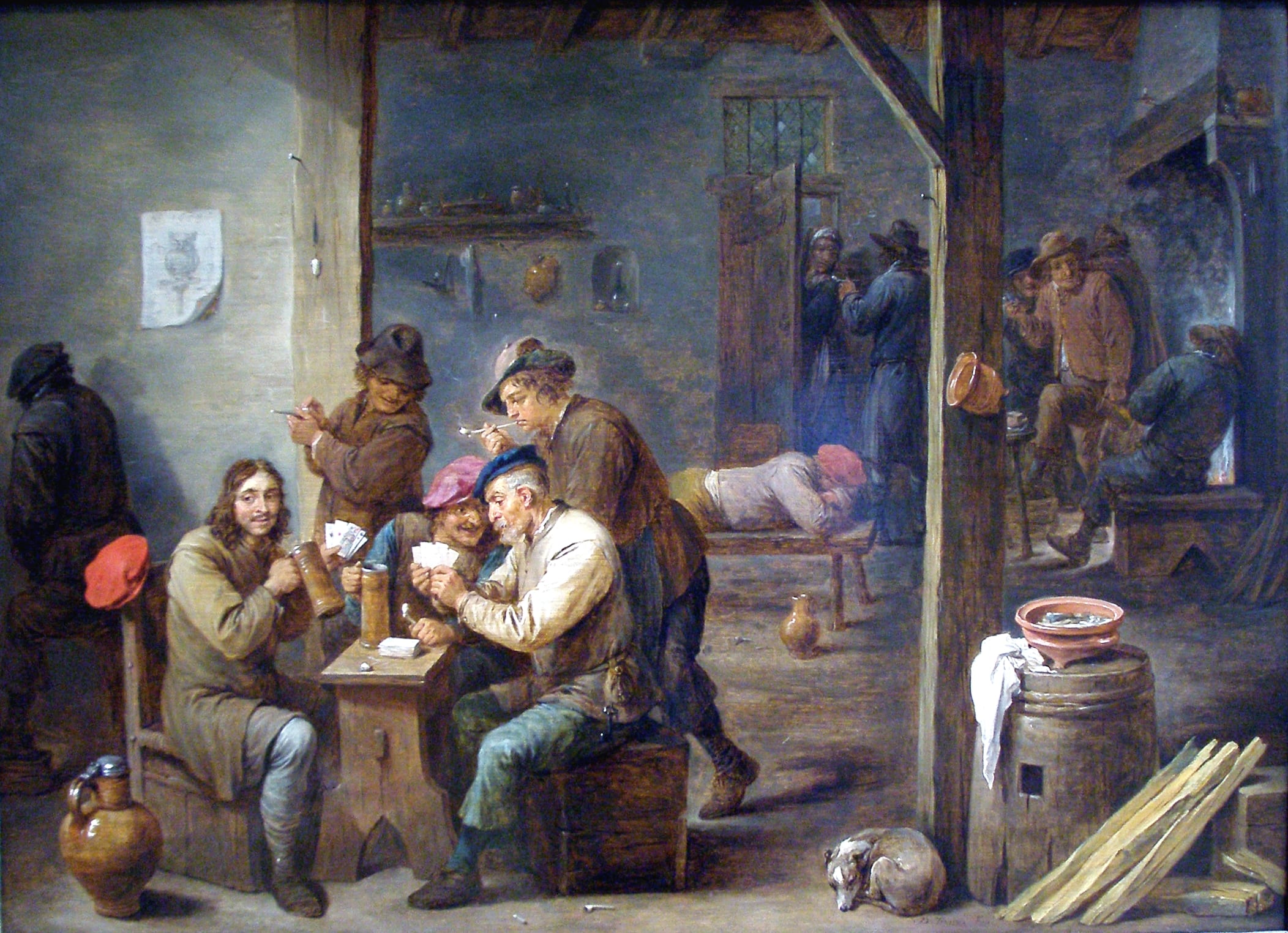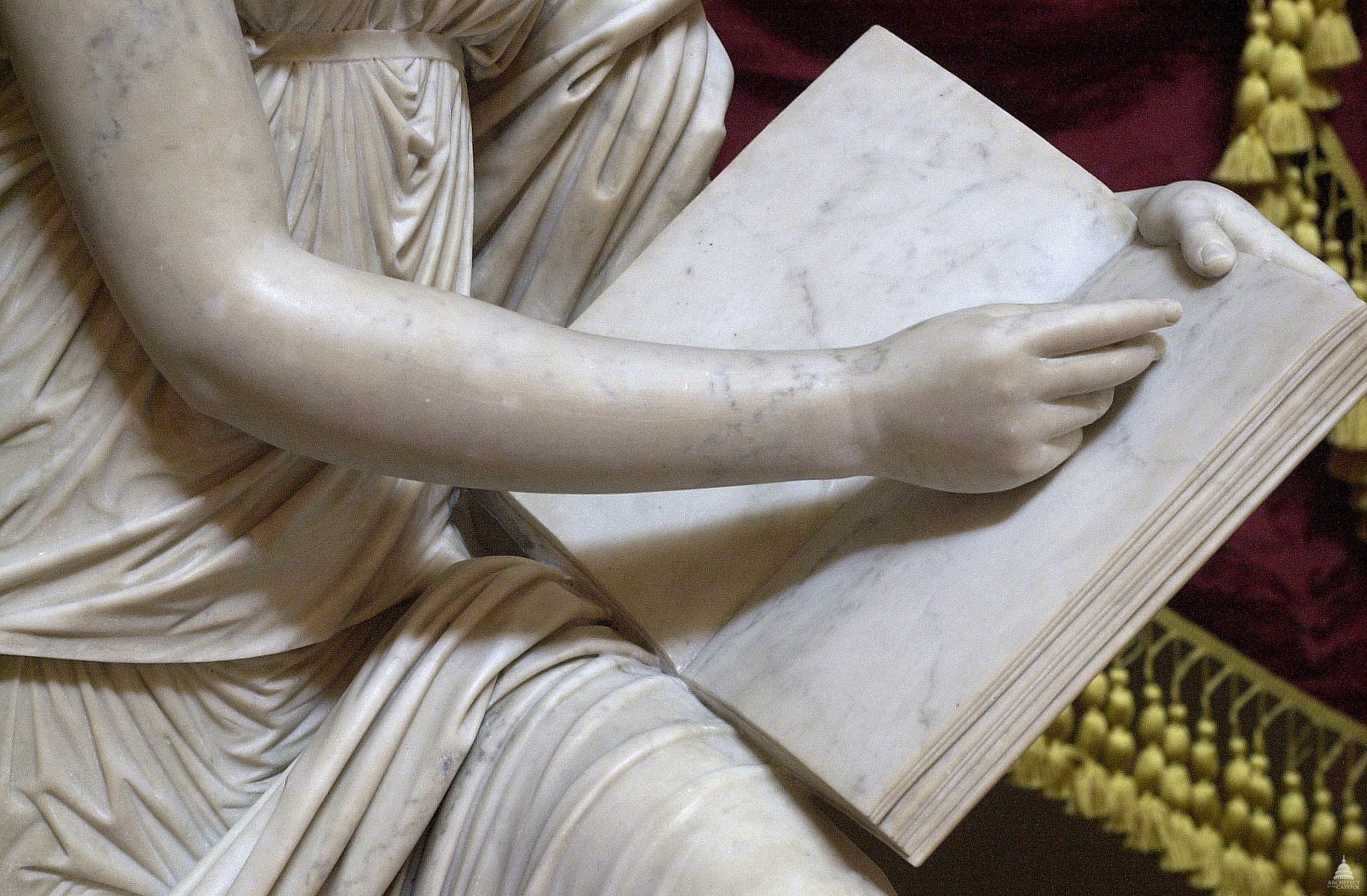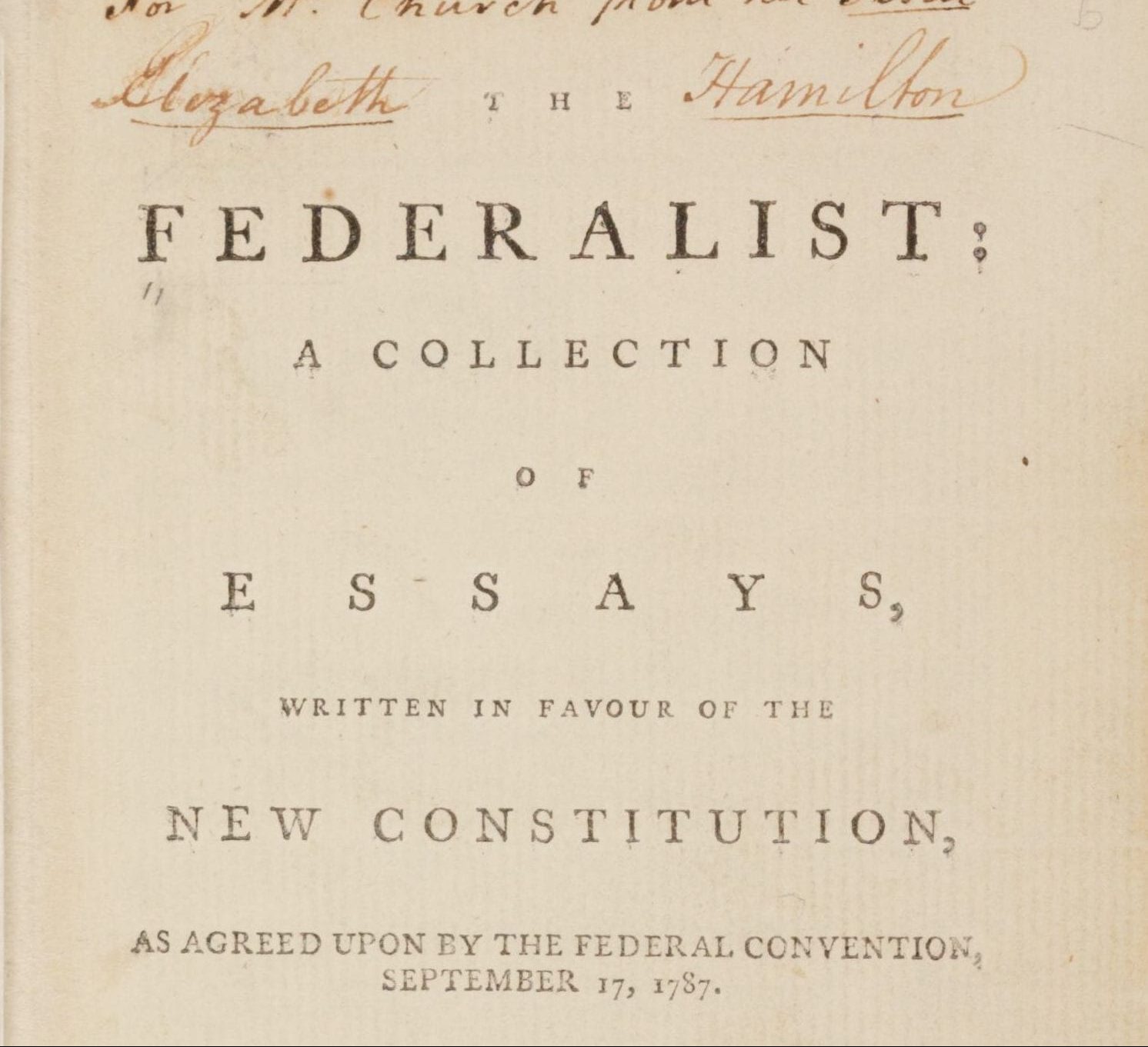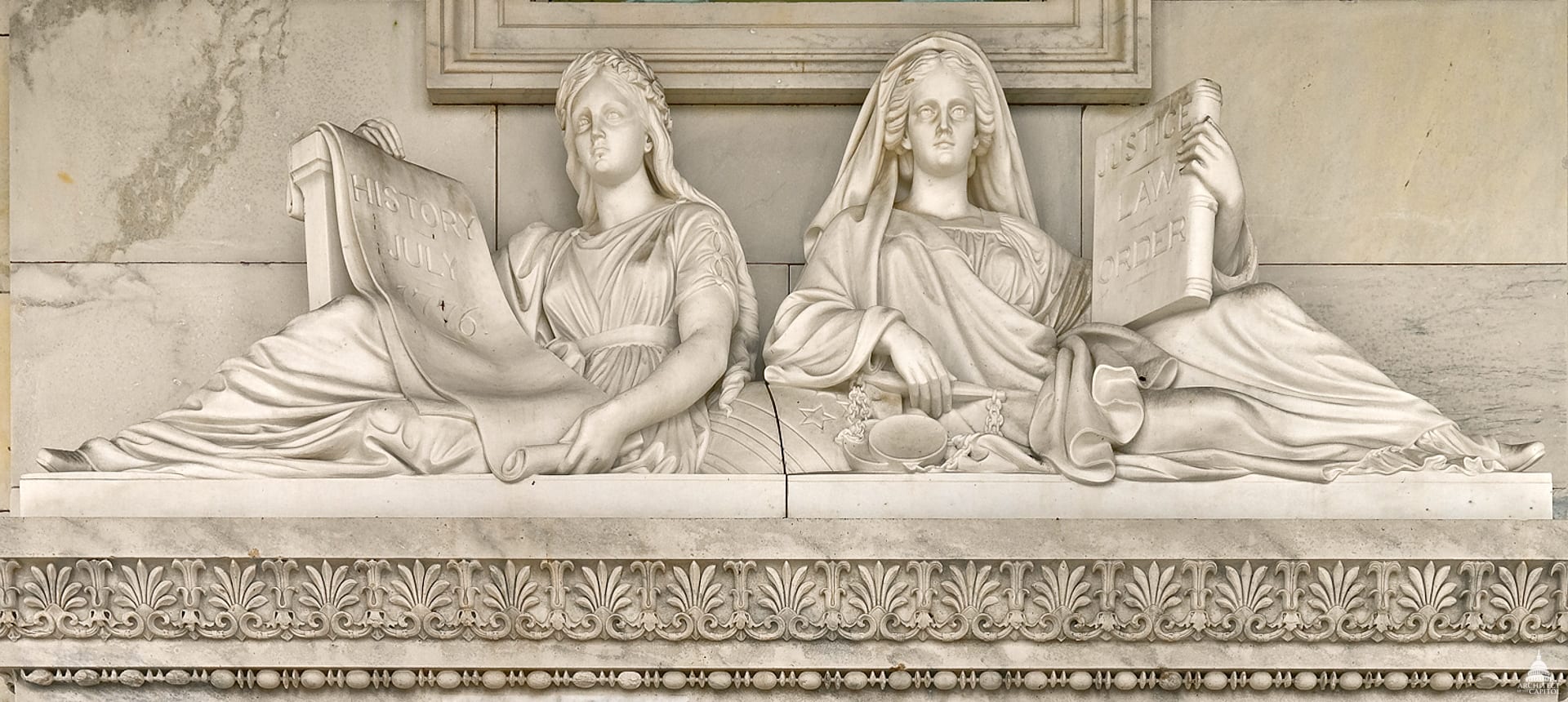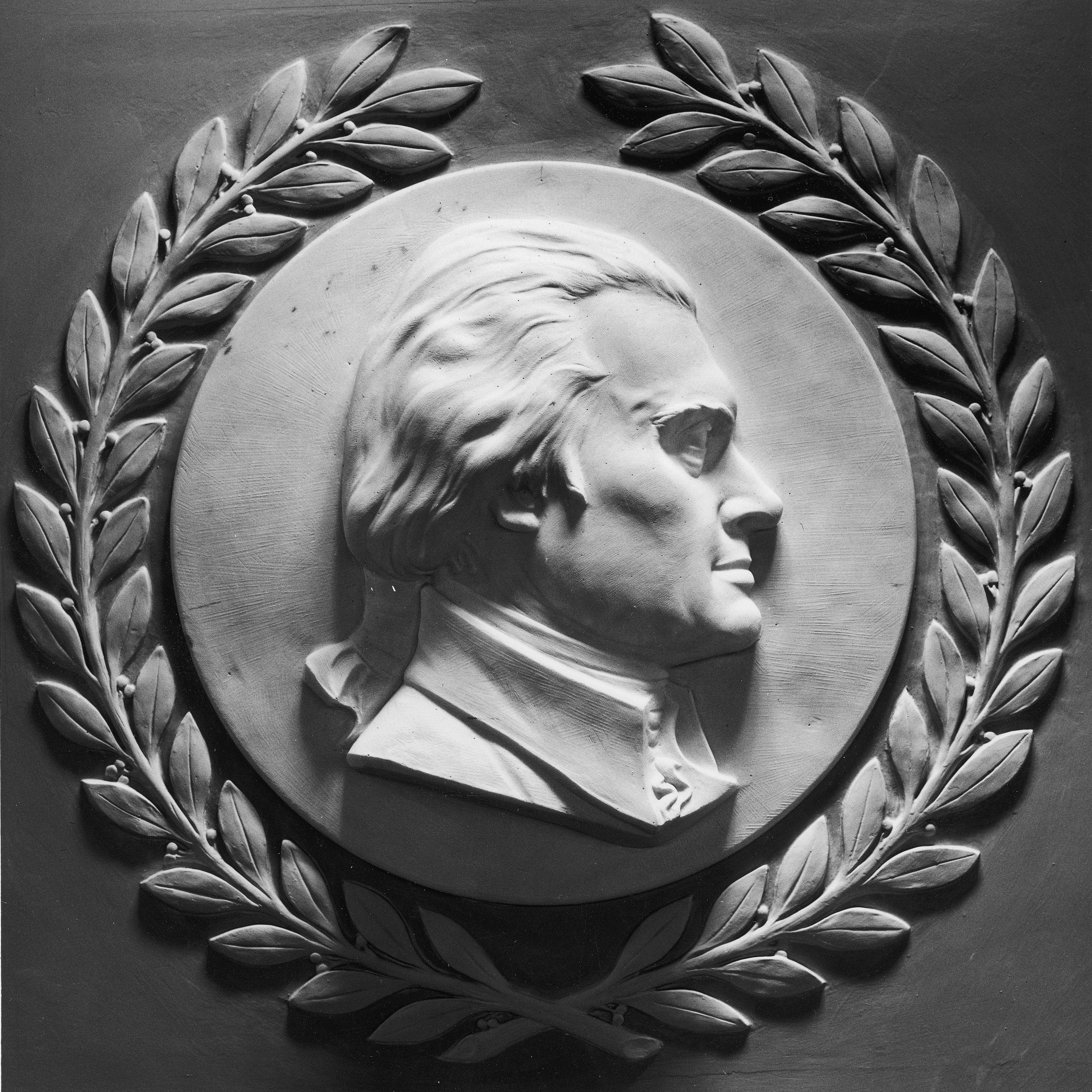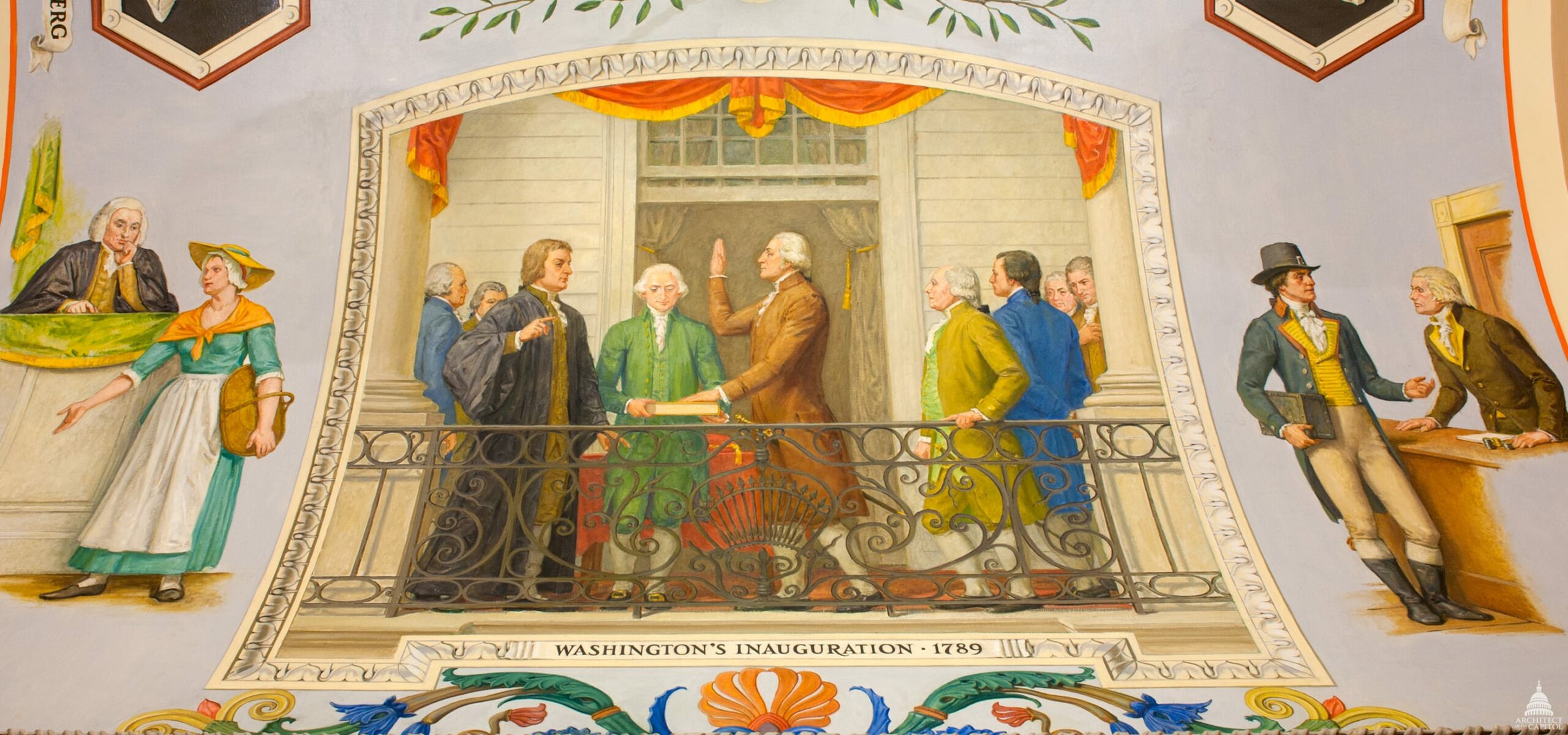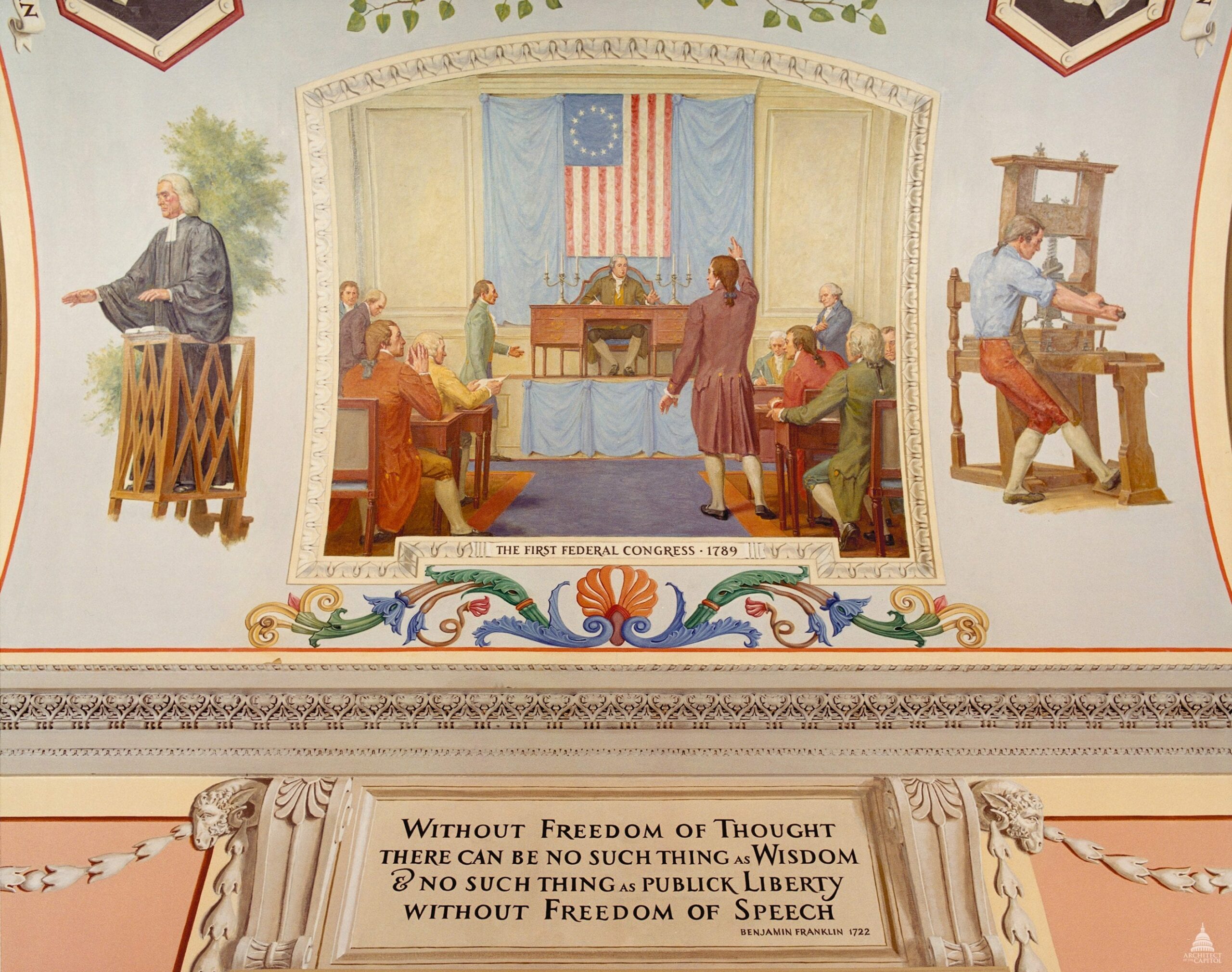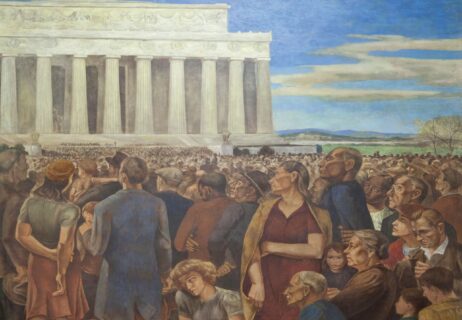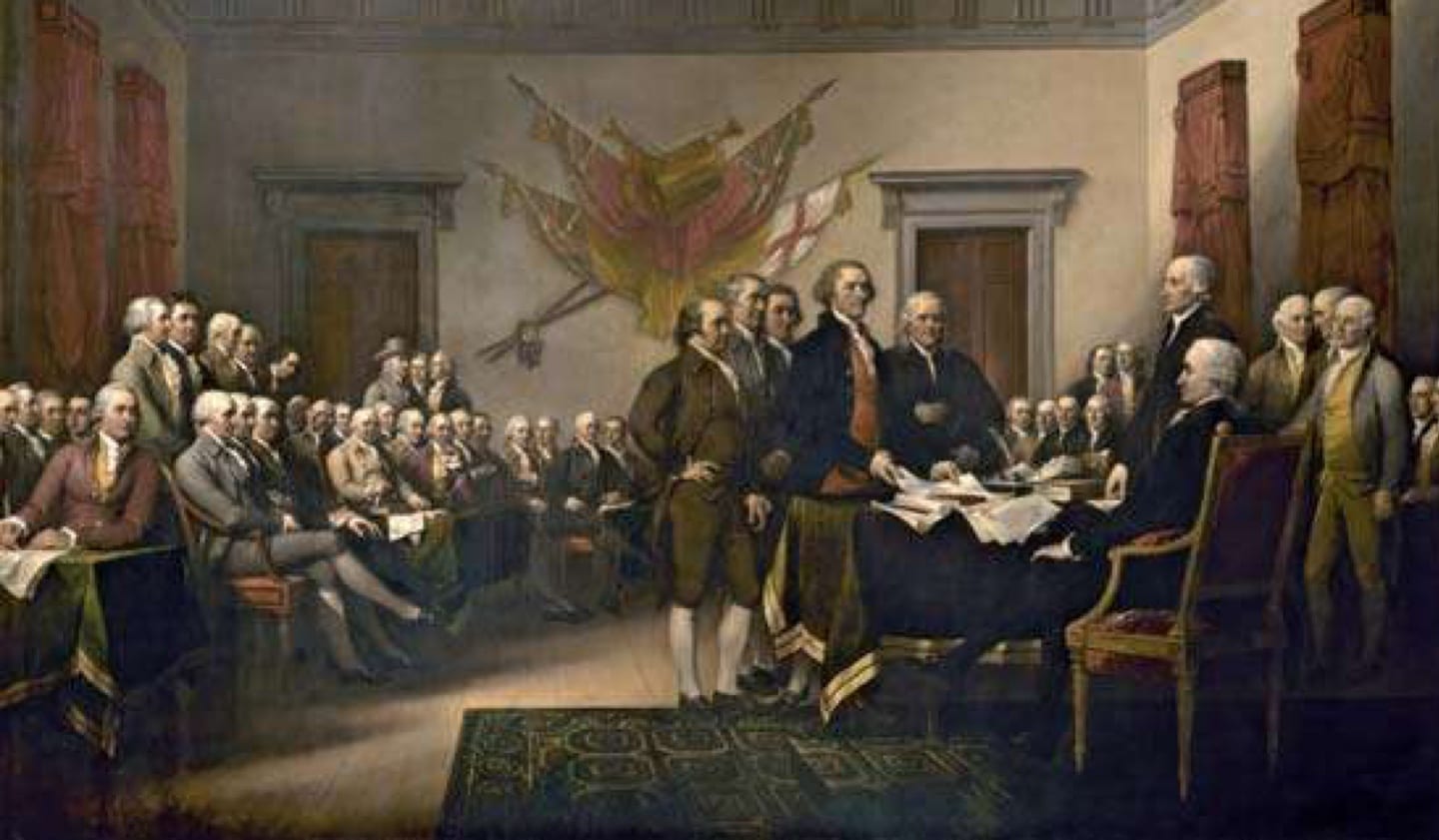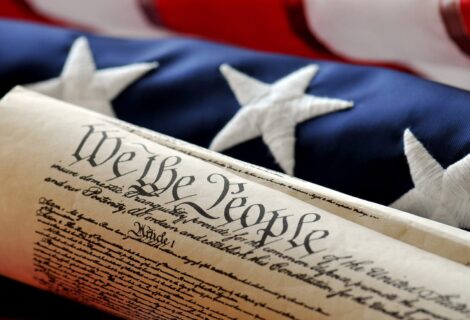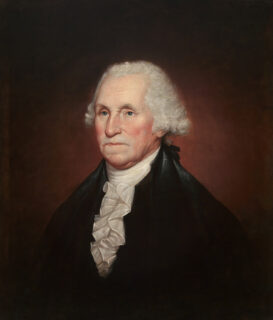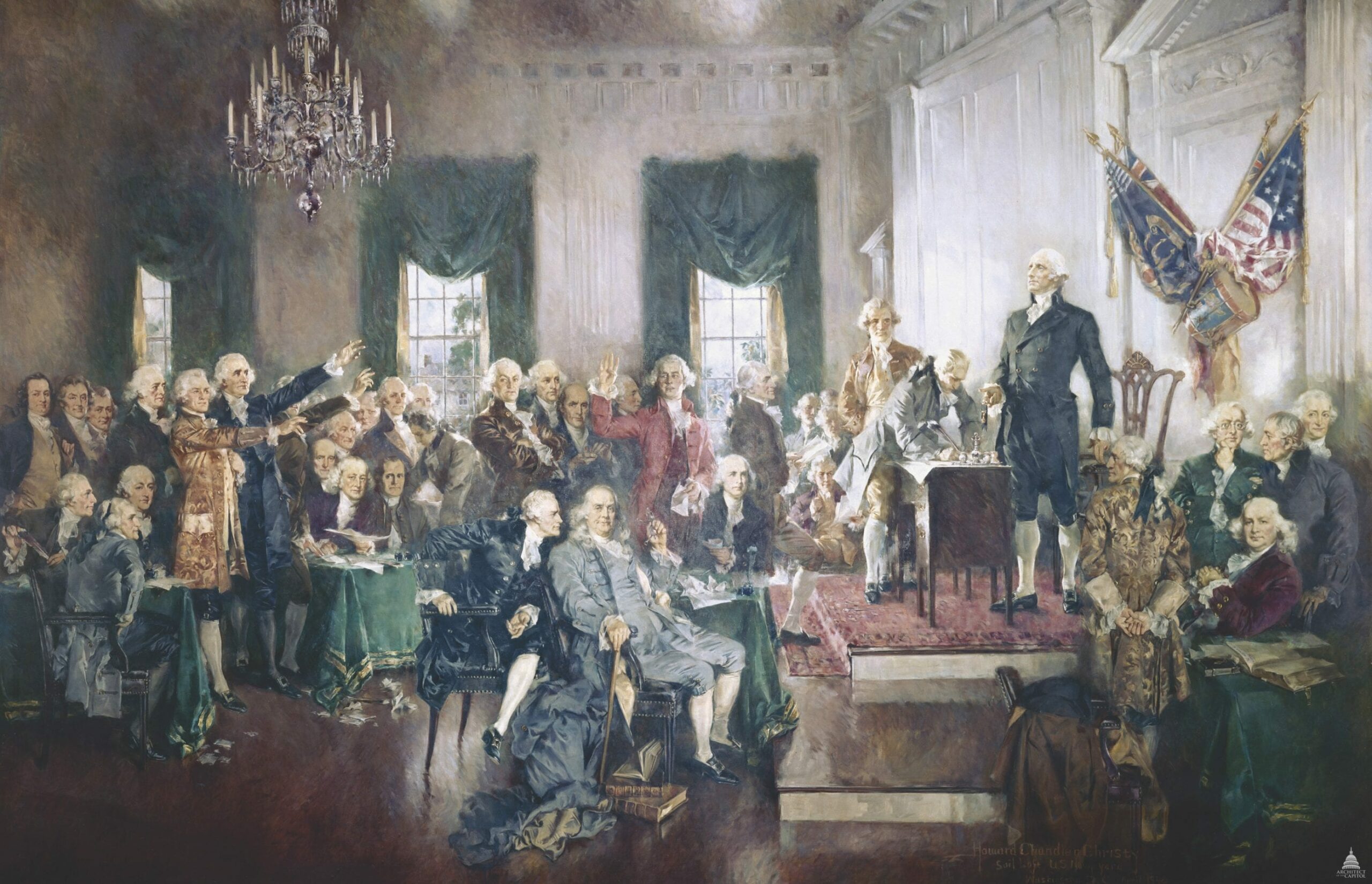
American Founding
This volume presents some of the documents necessary to understand the essential ideas and debates that shaped the founding of the American civic order. All reflection upon and action within that civic order, if they are to do any good, must rest on an understanding of these debates and ideas.
The volume opens with four documents that set the stage for the central drama of the Founding, the debates in the Constitutional Convention. The Virginia Declaration of Rights and the Virginia Constitution (1776) express some of the central ideas that justified the Revolution. These ideas appear in one form or another throughout the documents of the Founding period. They appear in Jefferson’s Draft of the Declaration of Independence (1776), written less than a month after Virginia adopted its Bill of Rights and Constitution. Jefferson’s Draft of the Declaration also raised the issue of slavery, an issue that would prove to be both central and problematic in the debates at the Constitutional Convention (Introducing a Fateful Compromise (1787); The Three-Fifths Clause Revisited (1787); The Slave Trade Clause (1787); The Fugitive Slave Trade Clause (1787)). The Articles of Confederation (1781) is the system of government under which the states fought for their independence, but which proved defective in the eyes of many Americans. James Madison summarized these defects in his 1787 memorandum, “Vices of the Political System of the United States”.
Madison’s memorandum, written in preparation for the convention, best shows how the mood of the Revolutionary generation had shifted from hope to concern in the decade following the writing of the Declaration. For most of those years, the revolutionary struggle itself overshadowed realization of the political challenges that would face the new republic of federated states. After peace was declared, disagreements and discontents relating to unpaid war debts, protectionist trade measures unilaterally imposed by individual states, and other matters threatened the unity of the nation and effectiveness of its central government. Madison suggested a special meeting, to be held outside of the Continental Congress, to resolve the interstate trade issues. The meeting occurred in Annapolis, Maryland in 1786. Only five states sent delegates, however, and the Annapolis meeting ended with a call for a Constitutional Convention. Anticipating this convention, George Washington wrote to Madison expressing his wish that “the Convention may adopt no temporizing expedient, but probe the defects of the Constitution to the bottom, and provide radical cures, whether they are agreed to or not.” This was the prompt Madison needed to write his memo. It became, in effect, the first draft of his famous defense of the extended republic in Federalist 10 (1787), one of a series of essays that Madison, Alexander Hamilton and John Jay wrote to defend the Constitution and secure its ratification.
Madison, Washington, and Hamilton, among others, had grasped that a fundamental ambiguity lay at the heart of the Articles of Confederation (1781). Article III stated that the union of the states was to be “a firm league of friendship,” and Article XIII declared that “the union shall be perpetual.” Yet, according to Article II, each state retained every power that was not “expressly delegated” to the Congress. Madison criticized the Articles because they lacked “the great vital principles of a Political Constitution,” namely, “sanction” and “coercion.” The “evil” that alarmed him the most was that individual rights were being violated by unjust majorities in the state legislatures. Focusing on this problem, Madison redirected the long-standing American conversation about rights. Instead of securing the rights of the people against the unrestrained conduct of monarchs and aristocrats, the new challenge was to secure the rights of minorities against omnipotent majorities in the legislative branch. He challenged “the efficacy” of such traditional republican solutions as “a prudent regard” for the common good, “respect for character,” and the restraints provided by religion. Instead, he argued, “a modification of the Sovereignty” was needed. The solution was to create an extended republic in which a multiplicity of opinions, passions, and interests “check each other.”
Before Madison and others could defend the proposed constitution, it had to be drafted. (The Virginia Plan (1787); Introducing a Fateful Compromise (1787); Return to a Starting Point (1787); The Hamilton Plan (1787); Partly National, Partly Federal (1787); The Gerry Committee (1787); The Three-Fifths Clause Revisited (1787); The Committee of Detail Report (1787); The Slave Trade Clause (1787); The Fugitive Slave Trade Clause (1787); Decline to Sign the Constitution (1787)) are excerpted from Madison’s account of the debate in the Constitutional Convention that met from May 25 to September 17, 1787, in Philadelphia. We are under no illusion that a reader’s favorite exchanges or speeches at the Constitutional Convention will necessarily be included in this collection. The June 6, 1787 exchange between Madison and Sherman as well as Franklin’s “More Perfect Union” speech on September 17, 1787 come to mind; both illuminate the essential issues at stake at the Convention. (The former is actually anticipated in Madison’s “Vices” (1787) and most fully articulated in Federalist 10 (1787), both of which are included in this collection. But to supply these absences, we are publishing a separate collection of documents on the Convention. We will also publish a separate collection of documents on the ratification debate, a volume that includes documents from selected state ratifying conventions as well as a greater selection of writings by those who supported and opposed ratification.
Yet we do include in this volume some writings from the debate over ratification (Centinel I (1787); Brutus I (1787); Federalist 1 (1787); Federalist 9 (1787); Federalist 10 (1787); Federalist 51 (1788); Brutus XV (1788); Federalist 78 (1788)). The most fundamental question these writings discuss is what a republic is, and therefore what kind of republican government is best. All the disputants agreed that, as the Declaration declared, all men are equal and thus must be governed only with their consent. But how must a republic and its government be structured so that self-government does not become tyranny or anarchy?
The Jefferson-Madison Exchange (1787-1789) is an exchange of letters between Madison and Thomas Jefferson, who was serving in Paris as America’s Ambassador to France during the Constitutional Convention and ratification process. Among other things, the two men discussed the need to add a bill of rights to the new Constitution. The lack of such a bill was a principal reason Antifederalists opposed the work of the convention. In their correspondence, Madison explained to Jefferson that the extended republic would secure the civil and religious rights of individuals from the danger of majority faction. Jefferson responded favorably two months later. He was troubled, however, by claims that a bill of rights was unnecessary. He reminded Madison that “a bill of rights is what the people are entitled to against every government on earth, general or particular; and what no just government should refuse, or rest on inference.” He listed six essential rights that should be declared: “freedom of religion, freedom of the press, protection against standing armies, restriction of monopolies, the eternal and unremitting force of the habeas corpus laws, and trials by jury in all matters.” Upon being informed by Madison that the Constitution had been adopted, he reiterated his list of six rights.
George Washington mentioned the need for a bill of rights in his First Inaugural Address (1789) and Madison, persuaded by Jefferson, argued forcefully for a guarantee of these rights in a speech to the new House of Representatives on June 8, 1789. These final two documents also show the new experiment in self-government at work, and thus bring to a fitting close the story of the American Founding.
Taken as a whole, the documents in this volume express six important themes in the American Founding. 1) How should a Constitution distribute the powers of government between the national government and the states? Should it follow the Articles of Confederation (1781), in enumerating these powers, as the New Jersey Plan (1787) does? Or should it leave them largely unspecified, like the Virginia Plan (1787)? 2) How should a Constitution allow for representation of the various participants—or interests—in the “scheme” to be devised? 3) Does a small territorial size, along with the virtue and homogeneity of the citizenry, matter for the well-being of a republic? Or should we move toward an extended commercial republic? 4) How might bicameralism and the separation of powers contribute toward effective government that still honors citizens’ freedoms? And how separate do the powers need to be to ensure that one branch of government does not encroach on another? 5) What are the sources of faction, and do we eliminate its cause or control its effects? 6) How important is a bill of rights to preserving federal decentralization and republican liberty?
The framers who met in the Constitutional Convention, the citizens who debated whether the resulting Constitution should be ratified, and the legislators who hammered out the first 10 amendments to it — the Bill of Rights — answered these questions. Yet in one form or another they continue to animate American political life.
To enhance the clarity of the documents for today’s readers, we have sometimes modernized spelling, capitalization or punctuation (although we refrained from doing so in the case of iconic documents such as the Declaration and Constitution, since in those cases a long publication history has preserved the original usage). We have footnoted individuals and events that might not be known to the modern reader. In addition, we have provided several appendices to give further context for the documents. One of these is a thematic table of contents that highlights the stages in the deliberations during the Founding.
In recording the debates at the Convention, Madison uses the terms “house” and “branch” interchangeably with reference to what would become the House of Representatives and the Senate. To modern ears, “branch” connotes the three divisions of our government (legislative, executive, and judicial). However, to respect the language used by Madison and the delegates, we generally use the term “legislative branches” when speaking of the two houses of Congress.
While a few delegates, following the British way of thinking, used the terms “upper” and “lower” to distinguish between what we call the House and the Senate, most delegates preferred to speak of the House of Representatives as the “first” branch of the legislature and of the Senate as the “second” branch. The terms “upper” and “lower” carried an aristocratic connotation. Madison and many other delegates preferred the more democratic terminology of “first” and “second.”
A NEW COURSE
- Virginia Declaration of Rights and Constitution (June 12 and 29, 1776)
- Jefferson’s Draft of the Declaration of Independence (July 2-4, 1776)
- Articles of Confederation (1781)
- “Vices of the Political System of the United States” (April 1787)
THE CONSTITUTIONAL CONVENTION (MAY 28, 1787 – SEPTEMBER 17, 1787)
The Three Alternative Plans
- The Virginia Plan (May 29, 1787)
- A Debate on Property and the Revised Virginia Plan (June 11 and 13, 1787)
- Return to Starting Point: The New Jersey Plan (June 15, 1787)
- The Hamilton Plan (June 18, 1787)
The Connecticut Compromise
- Partly National, Partly Federal (June 29 and 30, 1787. See also Document 6, June 11.)
- The Gerry Committee Report (July 2 and 5, 1787. See also Document 11, July 16, 1787)
Bicameralism and the Separation of Powers
The Slavery Clauses
- Introducing a Fateful Compromise: A Debate on Property (June 11 and 13, 1787)
- The Three-Fifths Clause Revisited (July 11 – 14 and July 16, 1787)
- The Slave Trade Clause (August 21, 22, 24 and 25, 1787)
- The Fugitive Slave Clause (July 14; August 6, 28, and 29; and September 12, 15, and 17, 1787)
Objections to the Constitution
The Ratification of the Constitution
- Centinel I (October 5, 1787)
- Brutus I (October 18, 1787)
- Federalist No. 1 (October 27, 1787)
- Federalist No. 9 (November 21, 1787)
- Federalist No. 10 (November 22, 1787)
- Federalist No. 51 (February 6, 1788)
- Brutus XV (March 20, 1788)
- Federalist No. 78 (May 28, 1788)
The Bill of Rights
- The Jefferson – Madison Exchange:
- Thomas Jefferson to James Madison (December 20, 1787)
- James Madison to Thomas Jefferson (Oct. 17, 1788)
- Thomas Jefferson to James Madison (March 15, 1789)
- George Washington’s First Inaugural Address (April 30, 1789)
- James Madison Argues for Constitutional Amendments (June 8, 1789)
For each of the Documents in this collection, we suggest below in section A questions relevant for that document alone and in Section B questions that require comparison between documents.
Virginia Declaration of Rights and Constitution (June 12 and 29, 1776)
A. Does it seem curious that a) the Virginia Declaration and the Virginia Constitution were written two weeks apart and that b) both preceded the passage of the Declaration of Independence? According to these two documents, what is the purpose of government? What is the role of the legislature, executive, and judiciary in the newly adopted Virginia Constitution? What sort of “republicanism” do these two documents express? Is it surprising that the Virginia Bill of Rights precedes the Virginia Constitution?
B. By what authority was the Virginia Declaration of Rights and Constitution initiated and adopted? Compare and contrast the Virginia authorization with other authorizations during the Founding period. (Draft of the Declaration (1776); The Articles of Confederation (1781); The Virginia Plan (1787); The Committee of Detail Report (1787)).
Thomas Jefferson, Draft of The Declaration of Independence (July 2–4, 1776)
A. Does Jefferson’s original draft of the Declaration convey a substantially different meaning from that of the document the Continental Congress signed? Would the less moderate tone of the draft have communicated a different message to the audience outside of America? To American loyalists and those uncertain whether to join the revolution? Is it likely that the explicit condemnation of slavery would have changed the conversation about slavery at the Founding or during the next eighty years?
B. Who or what is the authorization for the Declaration? Is there a parallel between the complaints listed in the Declaration and the rights to be secured by the Virginia Declaration of Rights (1776)? (The Articles of Confederation (1781); “Vices” (1787)).
The Articles of Confederation (1781)
A. Is there a central contradiction at the heart of the Articles, given that the union is supposed to be perpetual, “a firm league of friendship,” yet the powers of the union are “expressly delegated?” Is there a separation of powers under the Articles? Why is it significant that the delegates sign the document?
B. What is the status of the states under the Articles? How is the union to operate under the Articles? What is the difference between a confederation/federation and a national government with respect to: a) the structure of the institutions and b) the powers of the union? Compare the Articles to the Virginia Plan (1787), the New Jersey Plan (1787), and the solution proposed by Oliver Ellsworth in Partly National, Partly Federal (1787).
James Madison, “Vices of the Political System of the United States” (April 1787)
A. Why does Madison argue that the very structure of the Articles of Confederation needs to be altered? What is Madison’s case against the traditional small republic and how does that argument assist in his critique of the inadequacies of the Confederation?
B. Madison’s critique of the Articles does not assume that republican government will necessarily be supported by the virtue of the governed. How does this critique anticipate the Virginia Plan (1787) and the Hamilton Plan (1787)? How does it anticipate his argument in Federalist 10 (1787)?
The Virginia Plan (May 29, 1787)
A. Do the states have any significant role under the Virginia Plan? The Virginia Plan on the one hand seems to place principle responsibility for governing in the national legislature; but at the
same time, the proposed Council of Revision seems to tilt the balance of power toward the executive and the judiciary. Is there a tension at the heart of the Virginia Plan?
B. In what way is the Virginia Plan a radical departure from the Articles of Confederation (1781)? How is its vision of republicanism similar to, or different from, earlier and later statements of representative government? Compare it to the Virginia Declaration of Rights and Constitution (1776), the New Jersey Plan (1787), the Hamilton Plan (1787) and Madison’s account of representative government in Federalist 10 (1787).
A. Is the South Carolina delegates’ argument that “property” should be represented in republican government supported by real concerns about the financial challenges facing the new republic? What are the weaknesses in the South Carolina delegates’ argument? Why does Madison record the vote in favor of the Three-Fifths Compromise (1787) without comment?
B. Is the Revised Virginia Plan pretty much the same as the original Virginia Plan (1787)? Is there support in other founding documents for the representation of “property” in republican government? (Rough Draft of the Declaration (1776)).
Return to Starting Point: New Jersey Plan (June 15, 1787)
A. How are we to interpret Dickinson’s remark that it was Madison’s unwillingness to compromise that brought about this breakdown in negotiations?
B. Is the New Jersey Plan pretty much the same as the Articles of Confederation (1781)?. Where does the three-fifths clause fit into the New Jersey Plan and the revised Virginia Plan (1787)? Can we say that these two documents make it clear that the key debate is between the small states and the large states?
The Hamilton Plan (June 18, 1787)
A. Hamilton suggests that his plan is still within the proper sphere of both republicanism and federalism rather than a reformulation of monarchy and nationalism. Does his plan support his claim? Do the states have any role under his plan? Has he elevated the Presidency to a position of more importance than the Governors of the States?
B. Compare and contrast Hamilton’s position on the separation of powers with that found in the Virginia Plan (1787), the New Jersey Plan (1787), and the Committee of Detail Report (1787).
Partly National, Partly Federal (June 29 and 30, 1787)
A. When Ellsworth argues here on behalf of equal representation of the States in the Senate, is he offering a principled compromise? Is Madison’s argument that the great divide in American politics is the issue of slavery persuasive? How does the three-fifths clause become part of the discussion of representation? What role did Madison and Sherman play in response to the introduction of the three-fifths clause?
B. How is this discussion over the “partly national, partly federal” character of the union similar to and different from earlier and later discussions of the issue of federal representation? When Sherman argued earlier (Introducing a Fateful Compromise (1787)) on behalf of equal representation of the States in the Senate, was he arguing from principle? How does the debate on June 29 and 30 influence the later discussion of the three-fifths clause? (The Articles of Confederation (1781); The Virginia Plan (1787); Introducing a Fateful Compromise (1787); The New Jersey Plan (1787); The Hamilton Plan (1787); The Three-Fifths Clause Revisited (1787); The Committee of Detail Report (1787)).
The Gerry Committee Report (July 2 and 5, 1787)
A. Students of the American Founding are usually introduced to the partly national/partly federal nature of the Constitution through reading Federalist 39. In that essay, it is not completely clear where Madison (writing as Publius) stands on the five tests of federalism and nationalism to which he subjects the Constitution. At the Convention, Madison argues that the partly national/partly federal solution is unprincipled; what is his argument? Who at the Constitutional Convention understood the partly national/partly federal solution to rise to the level of principle, albeit a newly discovered principle? What kind of compromise is a 5-4-1 vote with 3 absent?
B. Reflect on the “dynamics” of the Convention between May 28 and the Report of the Gerry Committee. Who has “won,” and who has “lost” – or has everyone actually won by the time we get to July 16? (The Virginia Plan (1787); Introducing a Fateful Compromise (1787); The New Jersey Plan (1787); The Hamilton Plan (1787); Partly National, Partly Federal (1787); The Three-Fifths Clause Revisited (1787)).
The Three-Fifths Clause Revisited (July 11, 12, 13, 14 and 16, 1787)
A. Is it surprising that the South Carolina delegates want to count slaves as “five-fifths” of a person? Do they offer any logical grounds for this position? Why is the three-fifths clause embedded in a discussion about the “scheme of representation” appropriate for a federal republic?
B Do the arguments between July 11 and 16 on the representation of people, states, and wealth mirror and flesh out the discussions on June 11, June 29, and June 30, or do they break new ground? (Introducing a Fateful Compromise (1787); Partly National, Partly Federal (1787)).
The Committee of Detail Report (July 23, 24, and August 6, 1787)
A. From which states were the five delegates chosen? Does this matter? What strikes you as novel, and what as traditional, in this draft of the Constitution? Were there any changes made to the Connecticut Compromise that settled the structural or representative question? How does the Committee of Detail propose that the Constitution be adopted and altered?
B. Compare and contrast the powers of Congress listed in the Committee of Detail Report with the powers of Congress found in the Articles of Confederation (1781), the Virginia Plan (1787), the Revised Virginia Plan (1787), the New Jersey Plan (1787), and the final Constitution (Appendix D).
The Slave Trade Clause (August 21, 22, 24, and 25, 1787)
A. In what way did the Committee of Eleven alter the Report of the Committee of Detail concerning the slave trade? Who was on that Committee who wasn’t on the Committee of Detail? Did the delegates who voted against the 1808 compromise want a date of “never” or of 1800?
B. Why did it take until the end of August to consider the slave trade clause? Does this clause resolve issues raised by Sections 4, 5 and 6 of Article VII of the Committee of Detail Report (1787)? How does the Fugitive Slave Clause (1787) temper our understanding of the Founders’ expectation that the institution of slavery would end?
The Fugitive Slave Clause (July 14, August 6, 28, 29, September 12, 15, and 17, 1787)
A. What is the significance of the change in language from “justly” to “legally” to “under the laws thereof”? Why is the Fugitive Slave Clause located right under the Extradition Clause in the Constitution? Is there a significant difference between the language of the Fugitive Slave Clause and the Extradition Clause?
B. Do the fugitive slave clause and the three-fifths clause (1787) contradict the claim in the Declaration of Independence that all men are created equal? How do the discussions of these provisions in the Constitutional Convention address that question? What do the inclusion of these clauses and the inclusion of the ban on the slave trade (1787) tell us about the relationship between the Declaration and the Constitution?
Gerry, Mason, and Randolph Decline to Sign the Constitution (September 10, 12, 15, and 17, 1787)
A. Do Randolph, Gerry, and Mason have similar reasons for declining to sign the Constitution? Do they share a central concern about the Constitution? Other delegates had reservations, yet they still signed; do Randolph, Gerry and Mason expect a kind of perfection that would have been impossible? Or does their dissent demonstrate an admirable feature of the American experiment?
B. Prior to this point, other delegates have dissented to decisions made during the 88 days of the Constitutional Convention. See, for example, Patterson’s introduction of the New Jersey Plan (1787), Sherman’s objection to the Virginia Plan (1787) for representation in the Senate, Hamilton’s introduction of his own plan (1787), and Madison’s refusal to vote for the Connecticut Compromise (Partly National, Partly Federal (1787); The Gerry Committee Report (1787)). Does it strike you as a bit odd that Randolph, who introduced and defended the Virginia Plan, objected to signing the Constitution? What is so different about these three dissents from other objections? Compare, also, Jefferson’s objections to the new Constitution (Jefferson-Madison Exchange (1787-1789)) to those of Gerry, Mason, and Randolph.
A. What is it about the new Constitution that leads Centinel to argue that it contains the potentiality for a “permanent aristocracy”? Does he suggest a solution to this great difficulty?
B. Compare the remarks of Centinel with those made by Brutus (Brutus I (1787)) and Publius (Federalist 9 (1787); Federalist 10 (1787)) concerning the principles of the Constitution. How does Centinel’s argument about the need for virtue in a republican people contrast with Madison’s argument in Federalist 51 (1788)?
A. Does Brutus make a strong case for the momentousness of the choice facing Americans? For example, is the appeal to the wisdom of Montesquieu and the experience of history persuasive? With which powers of the new government is Brutus here especially concerned? Why does Brutus believe that a republic as large as the one proposed by the Constitution will lead to tyranny?
B. Compare and contrast Brutus’ arguments with those of Publius concerning 1) what is at stake in Federalist 1 (1787), 2) the status of Montesquieu – in Federalist 9 (1787), and 3) the case for the extended republic in Federalist 10 (1787).
Publius (Alexander Hamilton), Federalist 1 (October 27, 1787)
A. Publius opens Federalist 1 by raising the momentousness of the choice that lay before New Yorkers and the American people as a whole. What is it about “deliberation and choice” that Hamilton urges Americans to take seriously? Why is it critically important for Americans to ratify the Constitution? If Americans fail to choose well in the ratification process, what will they have proven to the world and their posterity? Why does Hamilton expect strong opposition to the Constitution from some Americans?
B. Do Brutus and Publius adequately summarize the choice facing the American people? What do each need to expand on or express more fully in the coming months of debate? Do you agree that the Antifederalists are in favor of disunion? (Brutus I (1787); Federalist 9 (1787); Federalist 10 (1787)).
Publius (Alexander Hamilton), Federalist 9 (November 21, 1787)
A. Which parts of the improved science of politics were wholly unknown to the ancients and which were inadequately understood? Is Montesquieu part of the ancient world as far as Publius is concerned?
B. Is Publius saying that the interpretation of Montesquieu by the Antifederalists is: a) wrong or b) irrelevant? Compare Federalist 9 with Centinel I (1787) and Brutus I (1787).
Publius (James Madison), Federalist 10 (November 22, 1787)
A. What does Madison mean by “faction”? What are the causes of faction? What is wrong with eliminating the causes of faction? Why is so little time spent on minority faction in Federalist 10? How does Publius define a republic? Why is an extended territory such an important element in Madison’s coverage of faction?
B. How does Publius’ argument in Federalist 10 compare and contrast with that of Brutus I (1787)?
Publius (James Madison), Federalist 51 (February 6, 1788)
A. According to Publius, what is the best way, in practice, to keep the powers of government properly separated among the branches? Why is framing a good government made difficult by human nature? What are the two possible sources of oppression and what remedies does Madison propose to prevent them?
B. Compare the argument in Federalist 51 about the great difficulty of founding a government with the argument of Brutus I (1787) and the arguments of Publius in Federalist 9 (1787) and Federalist 10 (1787).
A. Why does Brutus think that the Supreme Court is the most dangerous branch?
B. Compare and contrast the case made by Brutus that the Supreme Court is the most dangerous branch with the case made by Publius in Federalist 78 (1788) that the Supreme Court is the least dangerous branch.
Publius (Alexander Hamilton), Federalist 78 (May 28, 1788)
A. Why does Publius think that the judiciary is the least dangerous branch? Does he make the case for what we today would call judicial review? According to Publius, why is it safe to grant life tenure to federal judges?
B. Compare Publius’ defense of the Judiciary with the critique presented in Brutus XV (1788).
The Jefferson-Madison Exchange (December 20, 1787-March 15, 1789)
A. Did either Madison or Jefferson change his mind about a bill of rights as a result of this exchange? Do they approach the question with the same or with different priorities in mind? In the end, do they agree or disagree on the centrality of a bill of rights to securing republican liberty?
B. Between his exchange of letters with Jefferson and his June 8 speech to Congress (1789), how did Madison’s views on the need for a bill of rights develop? Compare the Jefferson-Madison exchange over the inclusion of a bill of rights that is consistent with the Constitution drafted by the Framers with Madison’s June 8 speech to Congress and Washington’s First Inaugural Address (1789). (Jefferson-Madison Exchange (1787-1789)).
George Washington, First Inaugural Address (April 30, 1789)
A. What is the “conflict in emotions” to which Washington refers? Beyond expressing his personal feelings at this moment, does this portion of the speech serve any public purpose? Why does Washington refer to “the invisible hand,” “providential agency” and “the propitious smiles of Heaven” at the beginning of his presidency? Does this language serve a public purpose?
B. Compare Washington’s comment on the “preservation of the sacred fire of liberty” to the opening paragraph of Federalist 1 (1787). Compare this speech also with Madison’s Speech to the First Congress (1789).
James Madison Argues for Constitutional Amendments (June 8, 1789)
A. What is Madison’s case for the adoption of a bill of rights? Why does he prefer to insert these rights into the text of the new Constitution?
B. Compare Madison’s case here for a bill of rights with his exchange with Jefferson. Are there any surprises in his list of 39 rights? How does his list of rights compare to those enumerated in the Virginia Declaration of Rights (1776)? To what extent do the 39 amendments he proposes answer the objections of Gerry, Mason, and Randolph, the three delegates to the convention who refused to sign the Constitution (1787)? To what extent does Madison’s list of rights answer the objections of Centinel I (1787)?
Allen, W. B., ed. George Washington: A Collection. Indianapolis: Liberty Classics, 1988.
Banning, Lance. Jefferson and Madison. Madison, WI: Madison House, 1995.
Beeman, Richard. Plain, Honest Men: The Making of the American Constitution. New York: Random House, 2009.
Bloom, Sol. History of the Formation of the Union Under the Constitution. Washington, DC: Government Printing Office. 1937.
Bowen, Catherine Drinker. Miracle at Philadelphia. New York: Little, Brown and Company, 1966.
Brant, Irving. James Madison: Father of the Constitution, 1787-1800. Indianapolis: Bobbs-Merrill Company, 1950.
Cogan, Neil H., ed. The Complete Bill of Rights: The Drafts, Debates, Sources, and Origins. Oxford: Oxford University Press, 1997.
Commager, Henry Steele, ed. Documents of American History. New York: Appleton-Century-Crofts, 1968.
Conley, Patrick T., and John P. Kaminski, eds. The Constitution and the States: The Role of the Original Thirteen in the Framing and Adoption of the Constitution. Madison, WI: Madison House, 1988.
Conley, Patrick T, and John P. Kaminski, eds. The Bill of Rights and the States: The Colonial and Revolutionary Origins of American Liberties. Madison: Madison House, 1992.
Elliot, Jonathan, ed. The Debates in the Several State Conventions on the Adoption of the Federal Constitution. 5 vols. Philadelphia: J.B. Lippencott Company, 1836.
Ferris, Robert, ed. Signers of the Constitution. Washington, DC: National Park Service, 1976.
Ford, Paul Leicester, ed. Pamphlets on the Constitution of the United States. New York: Da Capo Press, 1968.
Ford, W. C., ed. Journals of the Continental Congress: 1774-1789. Washington, DC: Government Printing Office, 1904.
Gales, Joseph, Sr., ed. Annals of Congress. Washington, DC: Government Printing Office, 1834.
Hening, W. W., ed. Statutes at Large. Richmond: George Cochran, 1823.
Hunt, Gaillard, ed. The Writings of James Madison. New York: G.P. Putman’s Sons, 1900-1910.
Hutchinson, William T., et al, eds. The Papers of James Madison. 17 vols. Chicago: University of Chicago Press; Charlottesville: University of Virginia Press, 1962-91.
Hyneman, Charles S., and Donald S. Lutz, eds. American Political Writings During the Founding Era. 2 vols. Indianapolis: Liberty Press, 1985.
Kurland, Philip B., and Ralph Lerner, eds. The Founders’ Constitution. 5 vols. Chicago: University of Chicago Press, 1987.
Jensen, Merrill, ed. Documentary History of the Ratification of the Constitution. Madison: State Historical Society of Wisconsin, 1976.
Lloyd, Gordon and Margie Lloyd, eds. The Essential Bill of Rights. Lanham, Maryland: University Press of America, 1998.
Lloyd, Gordon, ed. Debates in the Federal Convention of 1787 by James Madison, a Member. Ashland, Ohio: Ashbrook Center, 2014.
Labunski, Richard. James Madison and the Struggle for the Bill of Rights. Oxford: Oxford University Press, 2006.
Maier, Pauline. Ratification: The People Debate the Constitution, 1787-1788. New York: Simon and Schuster, 2010.
Main, Jackson Turner. The Antifederalists: Critics of the Constitution, 1781-1788. Chicago: Quadrangle Books, 1961.
McDonald, Forrest. E Pluribus Unum: The Formation of the American Republic, 1776-1790. Indianapolis: Liberty Fund: 1979.
McMaster, John B., and Frederick Stone, eds. Pennsylvania and the Federal Constitution, 1787-1788. Lancaster, PA: The Historical Society of Pennsylvania, 1888.
Morris, Richard B. Witness at the Creation. New York: New American Library, 1985.
Rossiter, Clinton. 1787: The Grand Convention. New York: The New American Library, 1966.
Rutland, Robert Allen, et al, eds. The Papers of James Madison. Chicago: University of Chicago Press, 1975.
Rutland, Robert Allen. The Ordeal of the Constitution: The Antifederalists and the Ratification Struggle of 1787-1788. Boston: Northeastern University Press, 1983.
Rutland, Robert Allen. The Birth of the Bill of Rights, 1776-1791. Boston: Northeastern University Press, 1983.
Schechter, Stephen L. and Richard Bernstein, eds. The Contexts of the Bill of Rights. Albany, New York: New York State Commission on the Bicentennial of the Constitution, 1990.
Stewart, David O. The Men Who Invented the Constitution. New York: Simon and Schuster, 2007.
Storing, Herbert, ed. The Complete Anti-Federalist. 7 vols. Chicago: University of Chicago Press, 1981.
Stryett, Harold and Jacob Cooke, eds. The Papers of Alexander Hamilton. 27 vols. New York: Columbia University Press, 1961-1987.
Swindler, William F., ed. Sources and Documents of United States Constitutions. Dobbs Ferry, NY: Oceana Publications, 1973.
Tansill, Charles. Documents Illustrative of the Formation of the Union of the United States. Washington, DC: Government Printing Office, 1927.
Thorpe, F.N., ed. The Federal and State Constitutions. 7 vols. Washington, DC: Government Printing Office, 1909.
Van Doren, Charles. The Great Rehearsal. New York: Penguin Books, 1986.
Veit, Helen, Kenneth Bowling, and Charles Bangs Bickford, eds. Creating the Bill of Rights: The Documentary Record of the First Federal Congress. Baltimore: The Johns Hopkins Press, 1991.
Vile, John R. The Writing and Ratification of the U.S. Constitution. Lanham, Maryland: Rowman and Littlefield, 2012.
Vile, John R. The Men Who Made The Constitution. Lanham, Maryland: Scarecrow Press, 2013.
Wood, Gordon S. The Creation of the American Republic, 1776-1787. Williamsburg, VA: Institute of Early American History and Culture, 1969.)

